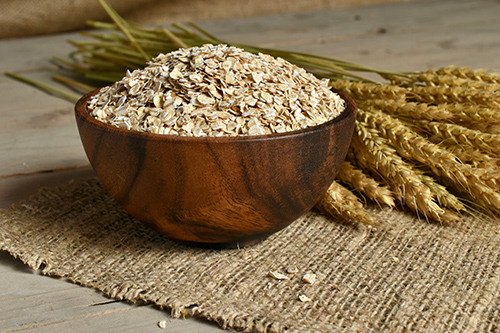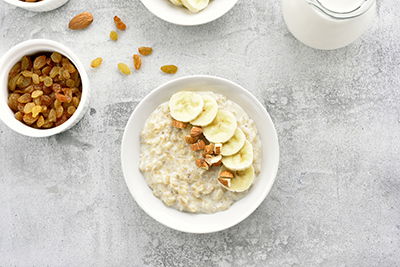It is a traditional practice in some countries in Central Europe to introduce the health benefits of oats to those suffering from nervousness or insomnia by having them sleep on a mattress of oat hay. It is possible that this custom is not without basis since oats contain an alkaloid sedating the nervous system.
However, this grain has been primarily used as animal feed in most European countries until a few decades ago, when the food industry discovered the significant health benefits of oats.
In some places, such as Scotland and Wales, people have eaten oats for centuries. Porridge (oatmeal) is the main dish of a typical Scots breakfast. On the other hand, oats were used primarily to feed animals in England. Perhaps this is the origin of the British saying, “Scotland produces the most beautiful, while England produces the most beautiful horses.”

Scientific Facts of Oats
- Scientific Name – Avena sativa L.
- Other Names – Rolled oats, Steelcut oats.
- French – Avoine
- Spanish – Avena.
- German – Hafer.
- Description – Fruit of the oat plant (‘Avena Sativa L.), an annual herbaceous plant of the botanical family Gramineae. This unique fruit is a grain composed of a pericarp, bran, seed, or the grain itself.
- Environment – Oats originated in Asia Minor (Turkey) and Central Asia. Today, their cultivation has extended to the temperate regions of the five continents.
Health Benefits of Oats
The health benefits of oats are a result of the most nutrient-rich grain. They comprise more than twice the fat as wheat, more proteins, and more carbohydrates. They are rich in phosphorous, iron (4.42 mg/100 grams, which surpasses meat with no more than 3 mg/100 grams), and vitamin B1.
The nutrient most abundant in oats is CARBOHYDRATES. Due to the distinct structure of the oat grain, these carbohydrates are easily absorbed and digested slowly. For this reason, oats deliver energy for hours. The below carbohydrates stick out on the oat:

- STARCH and its derivatives: dextrin, glucose, and maltose. These are easily digested substances that the body quickly transforms into energy.
- FRUCTOSE: This is noticed in a small amount of other carbohydrates. It has the oddity of requiring less insulin to be metabolized and produce energy. As a result, the health benefits of oats extend to people with diabetes.
- MUCILAGE: A carbohydrate with a gummy texture and a propensity to retain water. It constitutes a particular type of soluble fiber. It lubricates and softens the inside of the digestive tract. This makes the health benefits of oats excellent for gastritis and colitis.
- VEGETABLE FIBER: This is found mainly in the outer layer of the grain and remains in whole-grain flakes. It may also be eaten separately in the form of oat bran. Beta-glucan is its primary component, a soluble derivative of cellulose. It helps lower cholesterol and has a mild laxative effect. Its cholesterol-lowering ability is due to its ability to absorb and remove bile acids from the intestine. Bile is a raw material responsible for manufacturing cholesterol in the body.
Oat proteins are abundant (16.9 percent) and easily digested. They comprise all of the essential amino acids but not in optimal proportions. However, oats are very poor in threonine and lysine while possessing plenty of methionine. As a result, combining grains such as legumes with oats is highly beneficial; the proteins maintained by both foods work well together to form a complete protein.
The proteins in oats also combine well with milk proteins. The FATS in oats are also of great nutritional value and are formed of:

- FATTY ACIDS: Unsaturated (80 percent), including linolenic acid and saturated (20 percent). The dominance of unsaturated fatty acids has a normalizing effect on cholesterol synthesis.
- AVENASTEROL: This is a phytosterol, a vegetable substance similar to cholesterol. It has the interesting effect of interfering with the absorption of cholesterol in the intestine, reducing the levels in the blood.
- LECITHIN: Oats contain a tiny amount of this phospholipid essential to the nervous system’s function. Lecithin is also beneficial in the lowering of cholesterol.
Although oats possess fat, they should not be avoided by people wishing to lower cholesterol; quite the contrary. Oats have excellent nutritional value and are easy to digest, so they are hearty food in anyone’s diet. As with bread, it can be consumed daily because it is well-documented that grains are the basis for optimal human nutrition.
Because of the health benefits of oats, it is particularly recommended for the situations listed below:
Nervous system conditions—Oats provide essential nutrients for optimal neuron function: phosphorous, glucose (released from starch), lecithin, vitamin B1, and fatty acids. All of the above have a stabilizing and stimulating effect that helps improve mental performance. Also, oats possess small amounts of avenin, an alkaloid that is non-toxic and mildly soothing the nervous system.
Continuous consumption of oats in any form, including oat water, is recommended for the following ailments: insomnia, depression, mental exhaustion or fatigue, and nervousness. This food should be included in students’ diets, especially during exams.

Digestive conditions – Thanks to the mucilage content and easy digestibility, oatmeal (oat flakes) has a calming effect. When oats are cooked with vegetable broth or milk, it is highly recommended for gastroduodenal ulcers, gastritis, and intestinal disorders like diverticulosis (the presence of diverticula in the intestine), and colitis caused by toxins, microorganisms, medications, or specific food allergies. In most of these cases, oats may be the only or main dish for 3 to 5 days while the critical phase passes and the cells of the digestive mucosa are repaired.
Celiac disease – This specific disease is a result of the intolerance to gliadin, which is a protein that is found in wheat gluten and other grains. The symptoms are severe undernourishment and diarrhea. However, oats contain a tiny amount of gliadin and are tolerated well by people suffering from this condition. These results have been proven in various scientific studies.
Diabetes – Although oats have a high carbohydrate content, they are well tolerated by diabetics, especially if eaten as whole-grain flakes, including bran. This results from the fructose content, primarily from the BETA-GLUCAN explicitly found in oat bran. Beta-glucan is a form of soluble vegetable fiber that has been proven to improve tolerance by people with diabetes to glucose released from starch in oats during digestion, according to a United States Department of Agriculture study.
Increased cholesterol—The fat composition in oats promotes lowering cholesterol. This effect results from the action of beta-glucan, a substance found in oat bran. Beta-glucan eliminates and retains the bile salts in the intestine while reducing fats’ absorption. The body uses bile acids, a raw material, to produce cholesterol. While these are eliminated via feces, the production of cholesterol is reduced.
Various studies have proven this property of oats; therefore, the consumption of whole-grain oats, including the bran (as in wholemeal oat flakes), is highly advised for those suffering from elevated cholesterol.
Arteriosclerosis and high blood pressure—Continuous consumption of oats, at least once daily in any form, provides excellent results as a treatment and prevention for these conditions.
How to use Oats
- Flakes are the best way to reap the many health benefits of oats and take advantage of all their nutritional properties. They may be prepared by boiling them in milk or vegetable broth.
- Oatmeal (porridge) – You can prepare this in the following manner:
– place 4 Spoonfuls of oat flakes to soak.
– The following day, boil half a liter of water and add the soaked flakes.
– cook for fifteen minutes over low heat.
– serve with honey.
– you can add milk as well. - Cream or flour – Use for baby foods or soups.
- Muesli—One of the primary ingredients in “muesli” is oat flakes, also used as breakfast food alongside other grains like hazelnuts, almonds, raisins, etc. You can prepare “Bircher-muesli” with these ingredients and fresh milk, honey, and fruit.
- Oat water – This particular water is prepared by placing 2 soupspoons of oat grain in 1 liter of water. The resulting liquid can be sweetened with honey. You can drink oat water throughout the day.
DISCLAIMER: All content on this website is presented solely for educational and informational objectives. Do not rely on the information provided as a replacement for advice, diagnosis, or treatment from a qualified medical expert. If you are pregnant, nursing, or have any preexisting medical concerns, talk to your doctor before using any herbal or natural medicines.
REFERENCES
- George D. Pamplona-Roger, M.D. “Encyclopedia of Foods and Their Healing Power.” George D. Pamplona-Roger, M.D. Encyclopedia of Foods and Their Healing Power. Trans. Annette Melgosa. Vol. 2. Chai Wan: Editorial Safeliz, 2005. 41, 42, 43. Print.
- https://www.heart.org/en/news/2022/09/01/take-a-fresh-look-at-oatmeal-its-not-as-simple-as-you-think
- https://www.hsph.harvard.edu/nutritionsource/food-features/oats
- https://www.webmd.com/diet/health-benefits-oatmeal
- https://www.healthline.com/nutrition/9-benefits-oats-oatmeal
Last update on 2025-06-04 / Affiliate links / Images from Amazon Product Advertising API





